Abstract
Chromosome 21 is the smallest autosome, comprising only about 1.9% of human DNA, but represents one of the most intensively studied regions of the genome. Much of the interest in chromosome 21 can be attributed to its association with Down's syndrome, a genetic disorder that afflicts one in every 700 to 1000 newborns. Although only 17 genes have been assigned to chromosome 21, a very large number of cloned DNA segments of unknown function have been isolated and regionally mapped. The majority of these segments detect restriction fragment length polymorphisms (RFLPs) and therefore represent useful genetic markers. Continued molecular genetic investigation of chromosome 21 will be central to elucidating molecular events leading to meiotic non-disjunction and consequent trisomy, the contribution of specific genes to the pathology of Down's syndrome, and the possible role of chromosome 21 in Alzheimer's disease and other as yet unmapped genetic defects.
Full text
PDF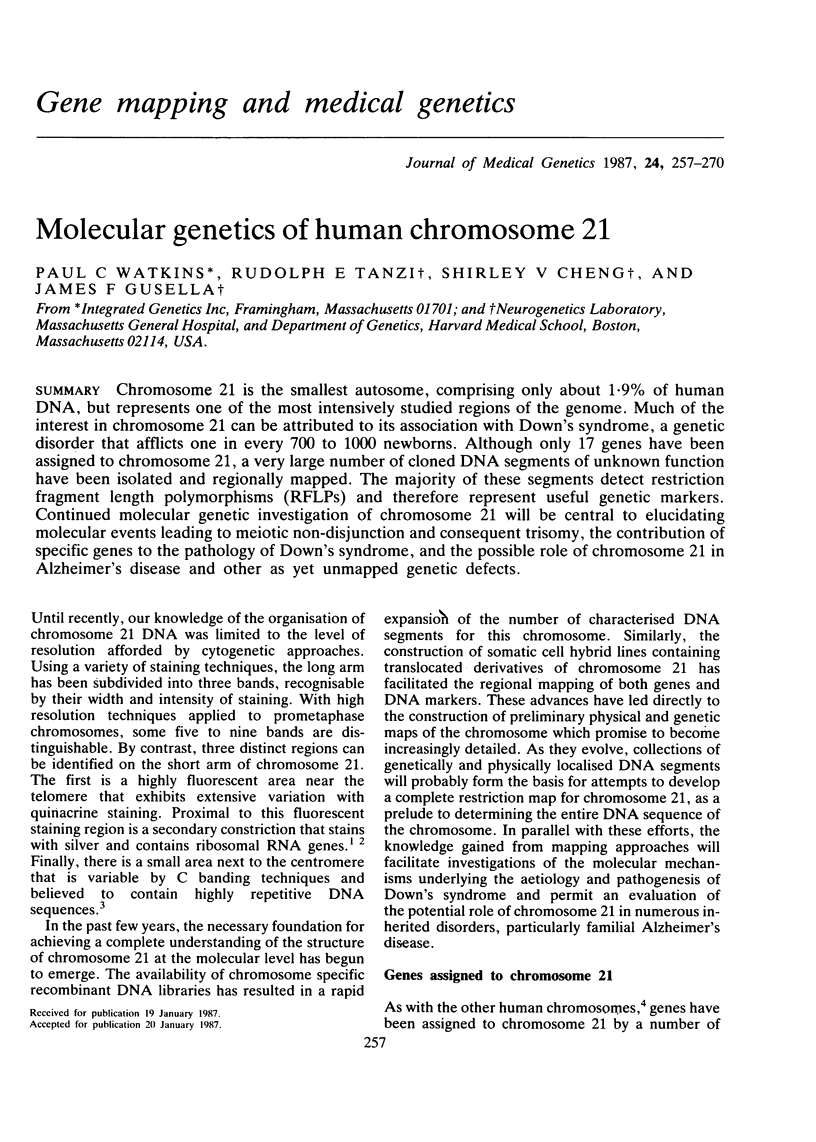
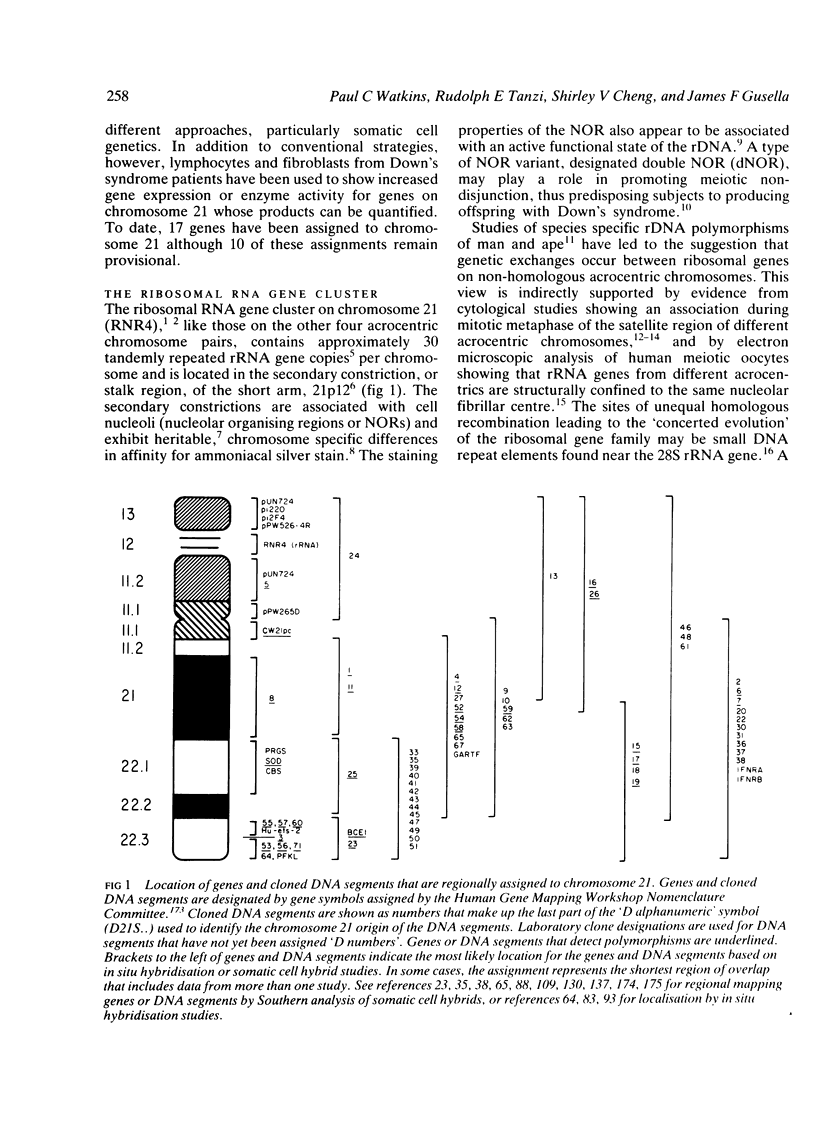
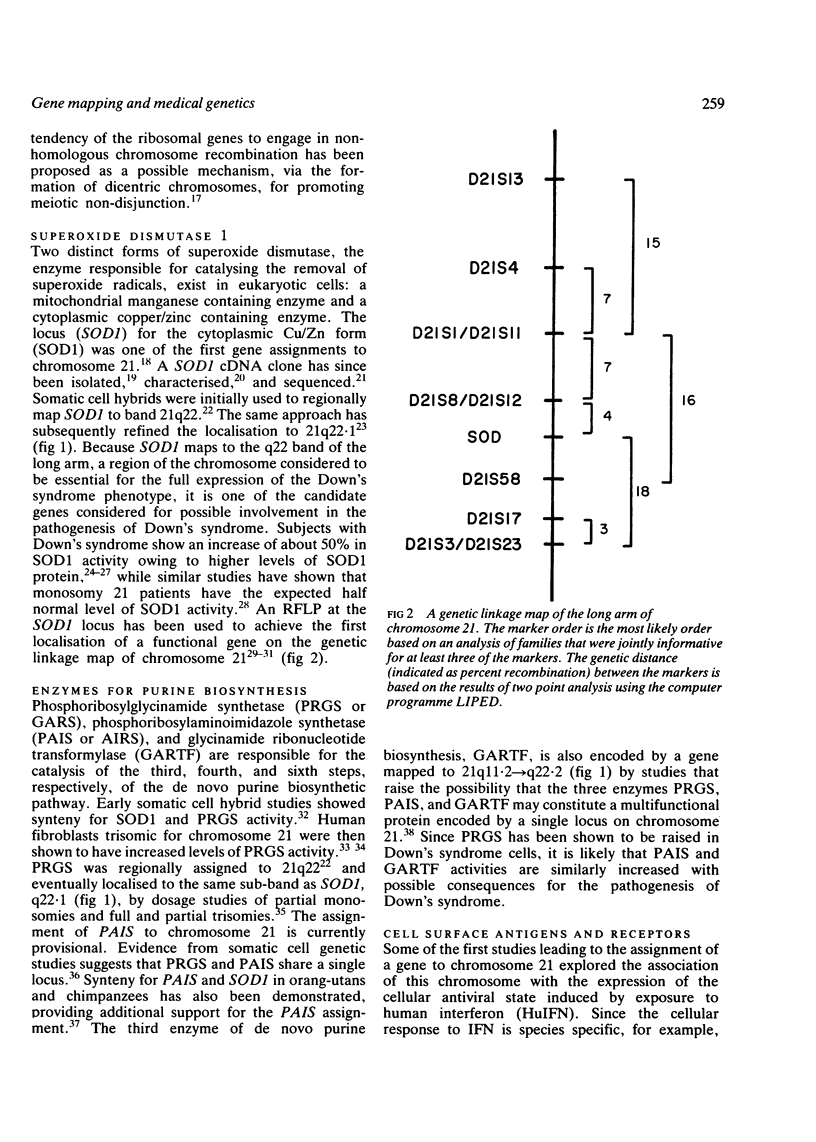
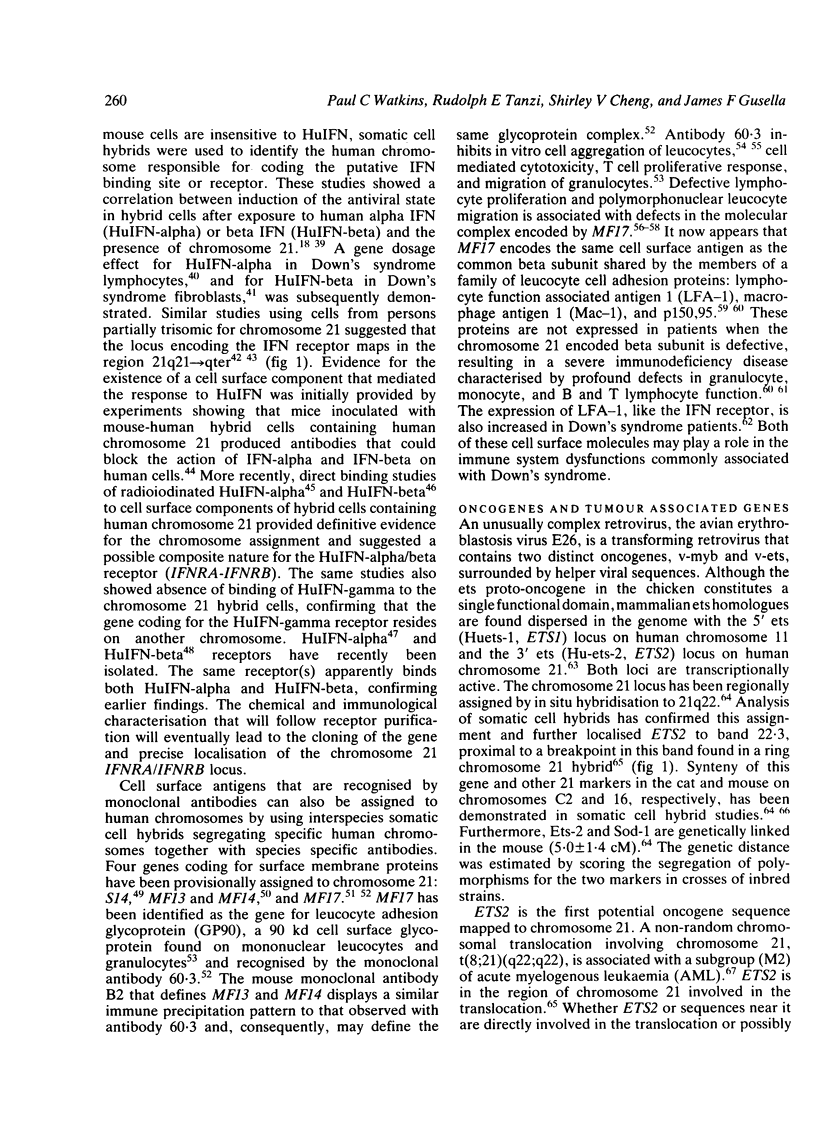
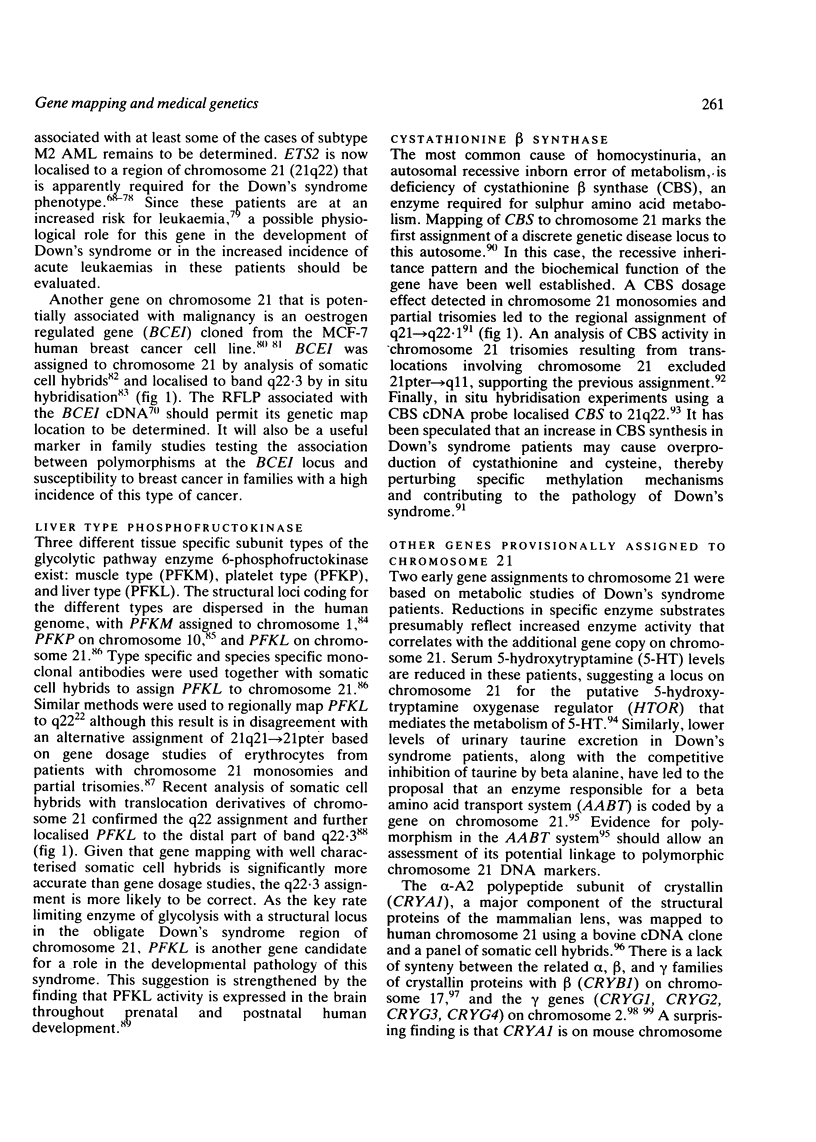
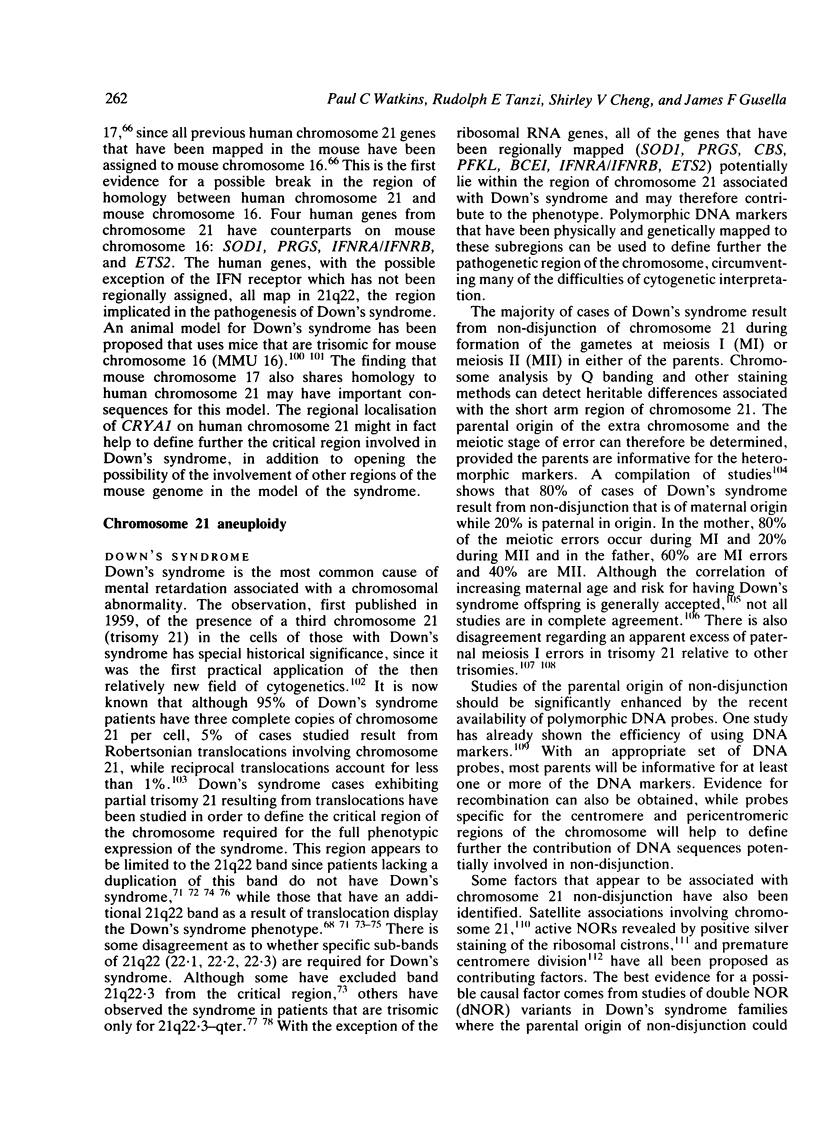
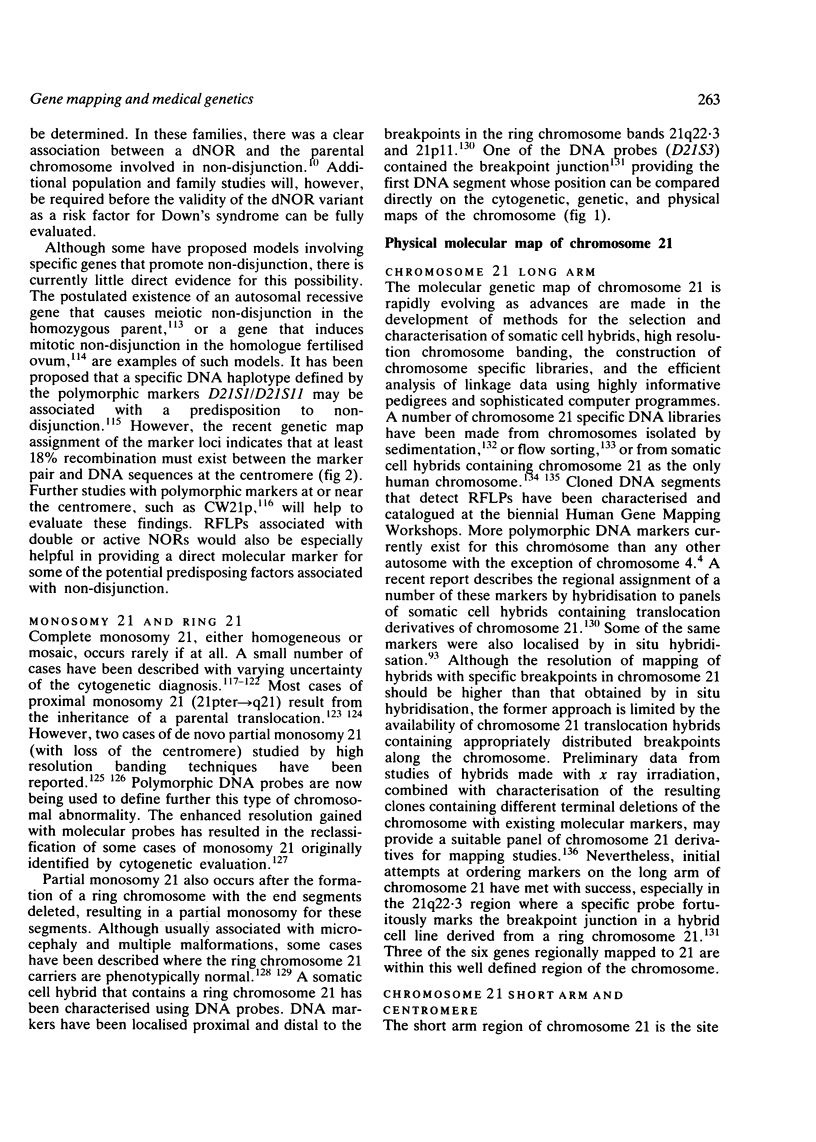
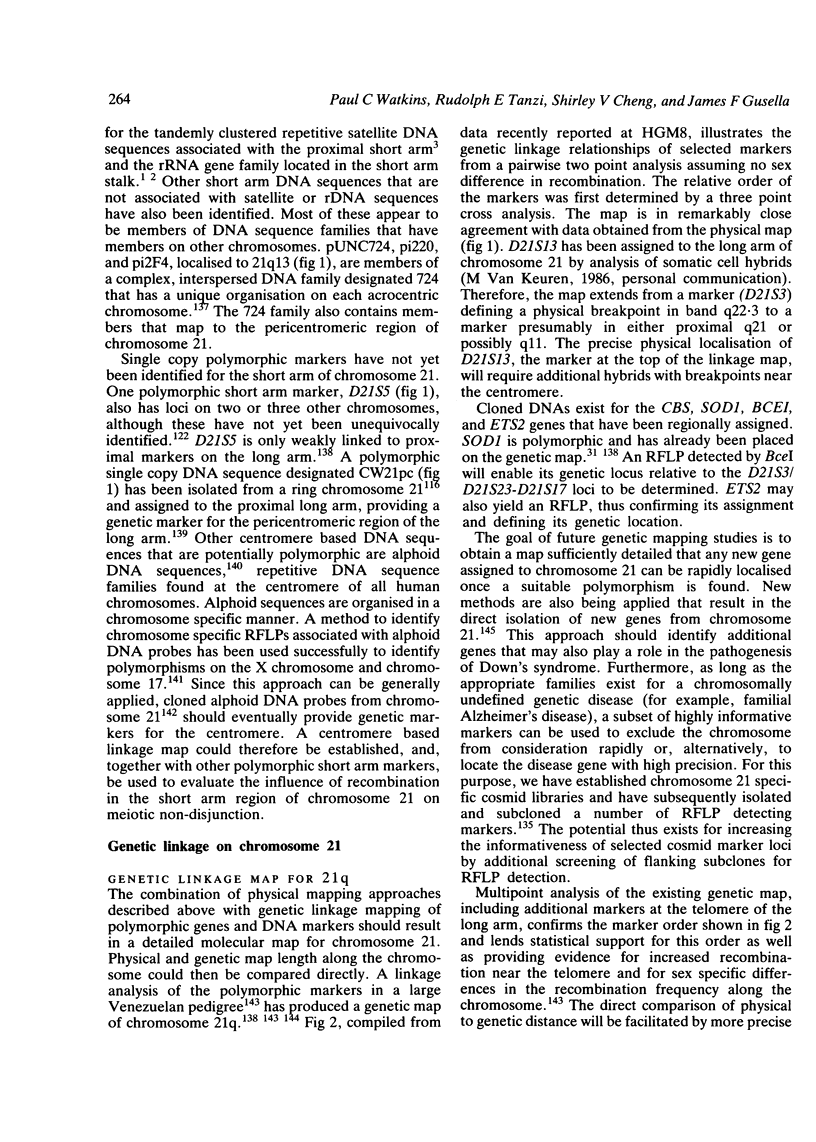
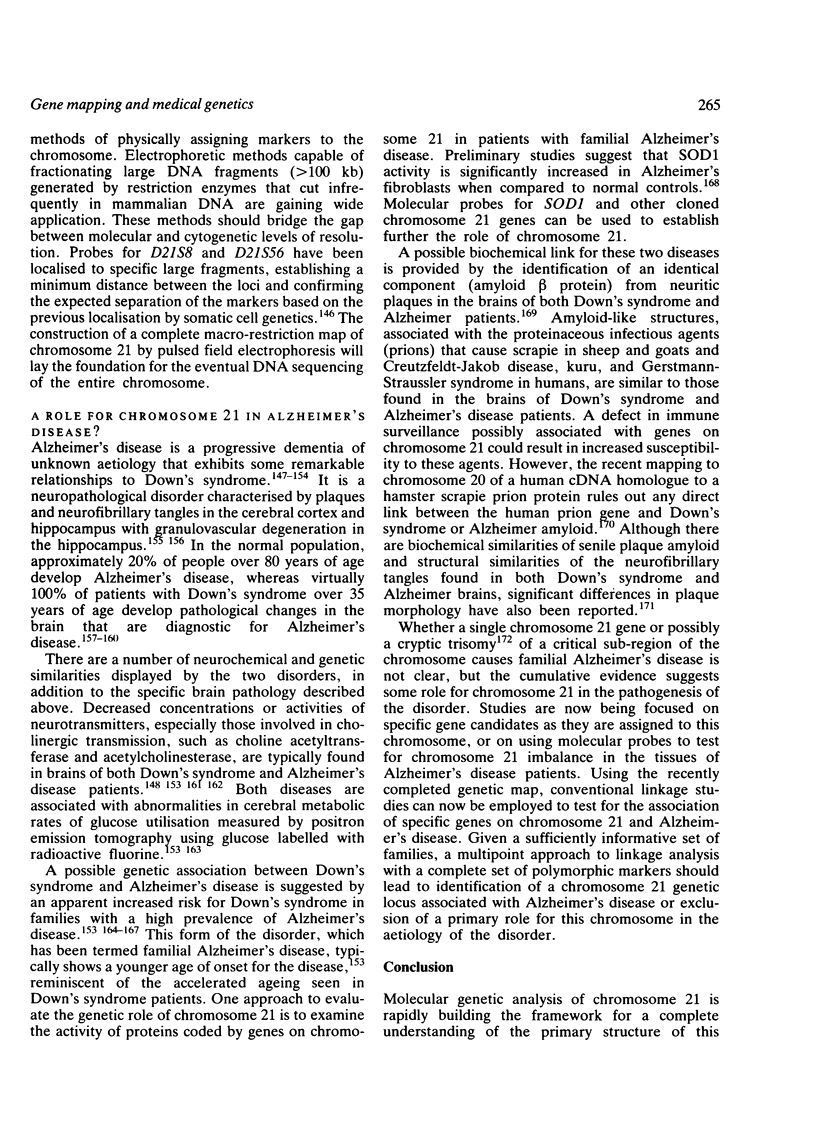
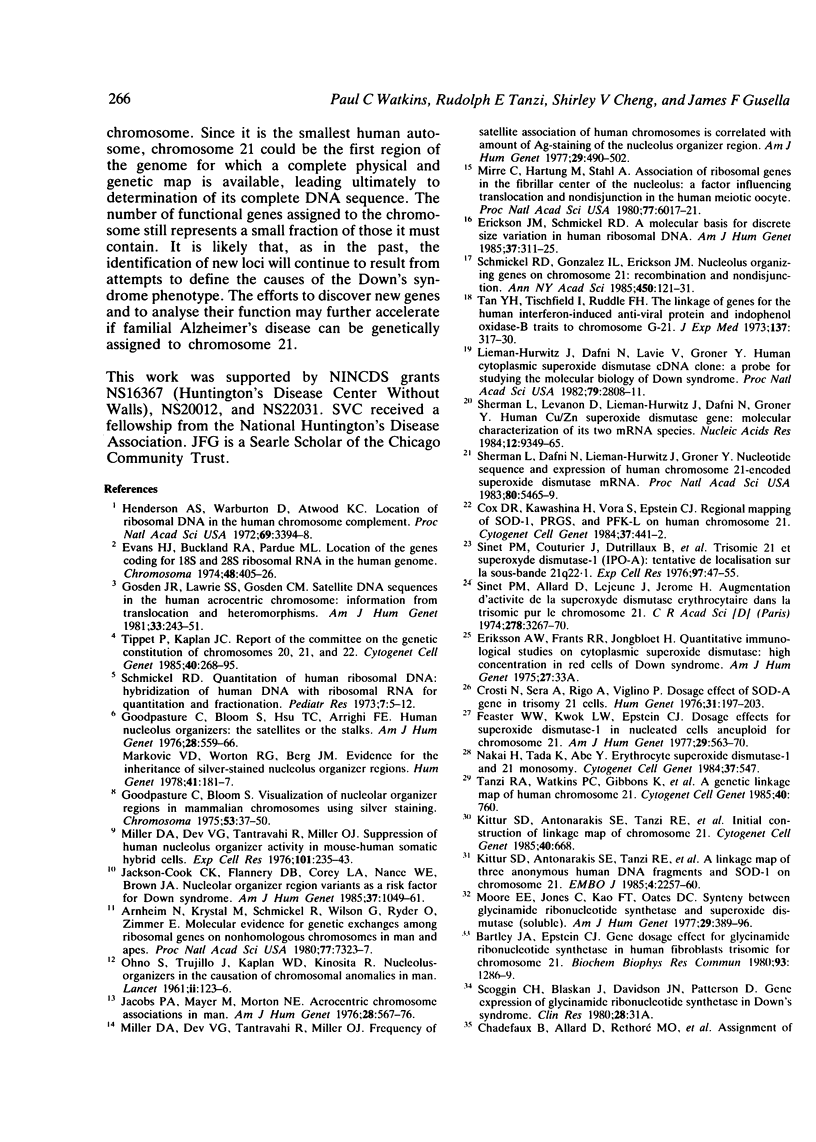
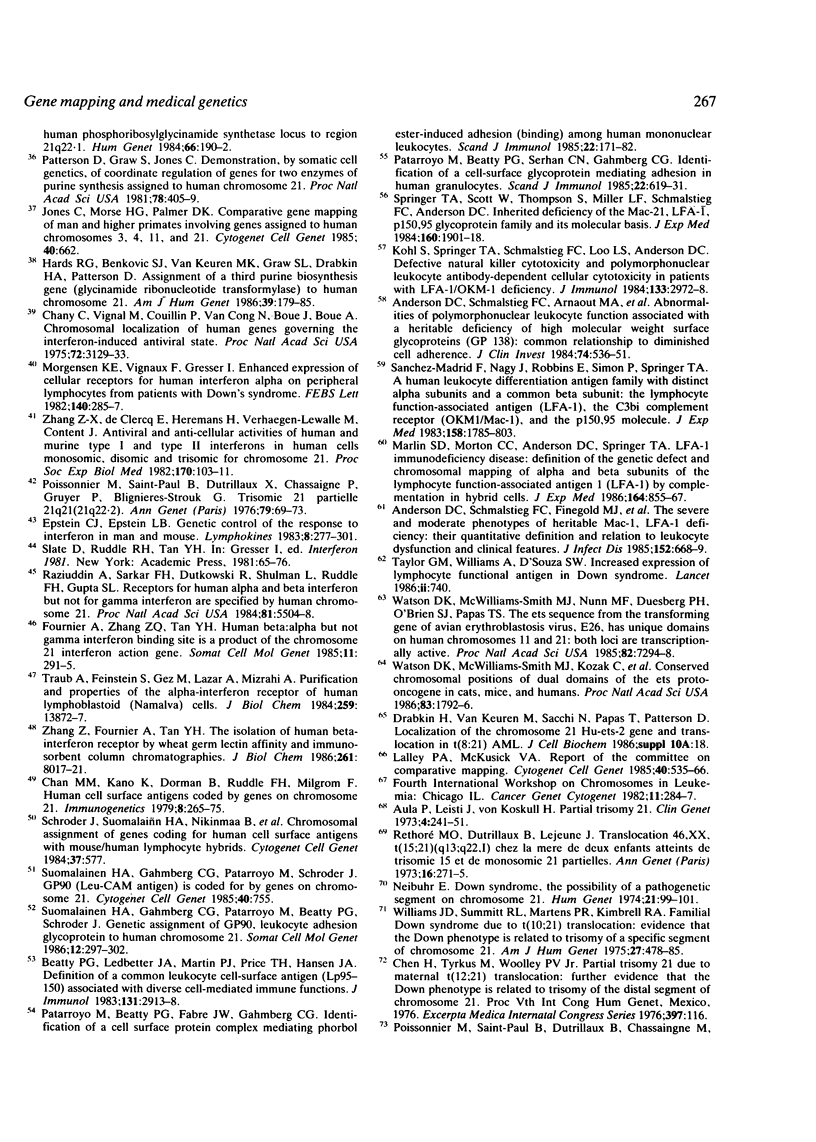
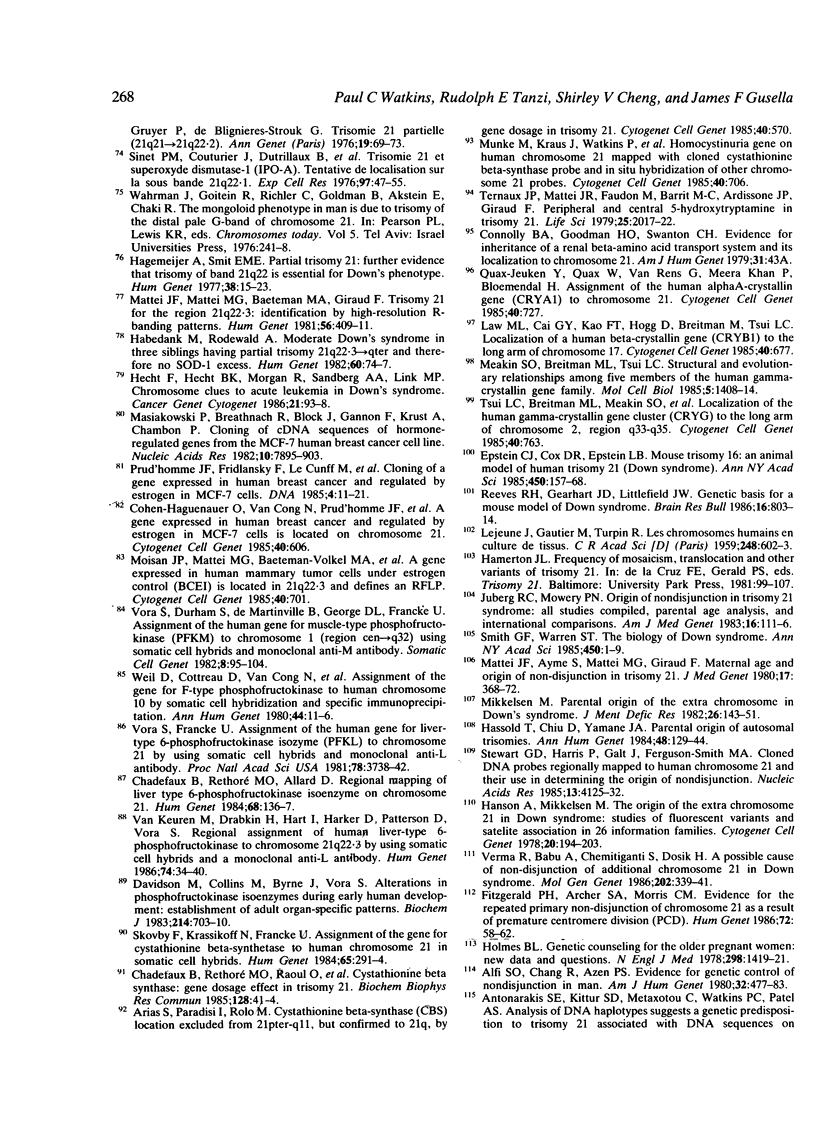
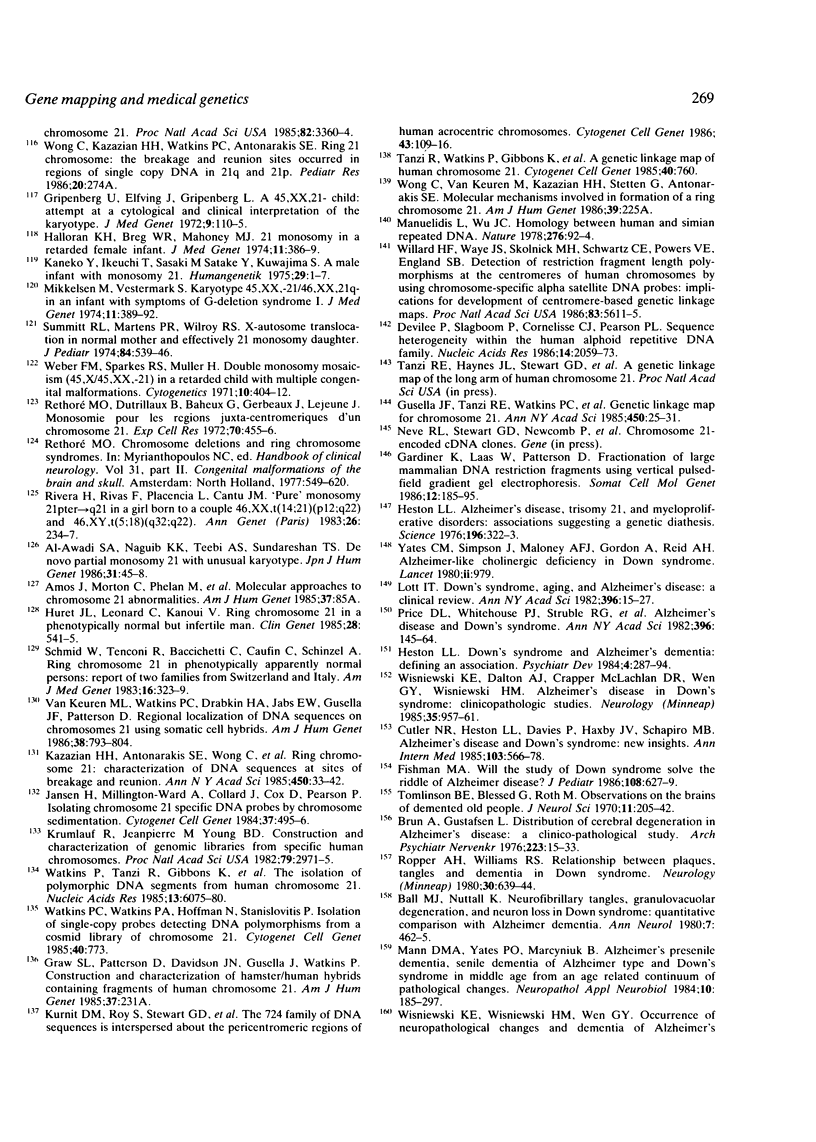
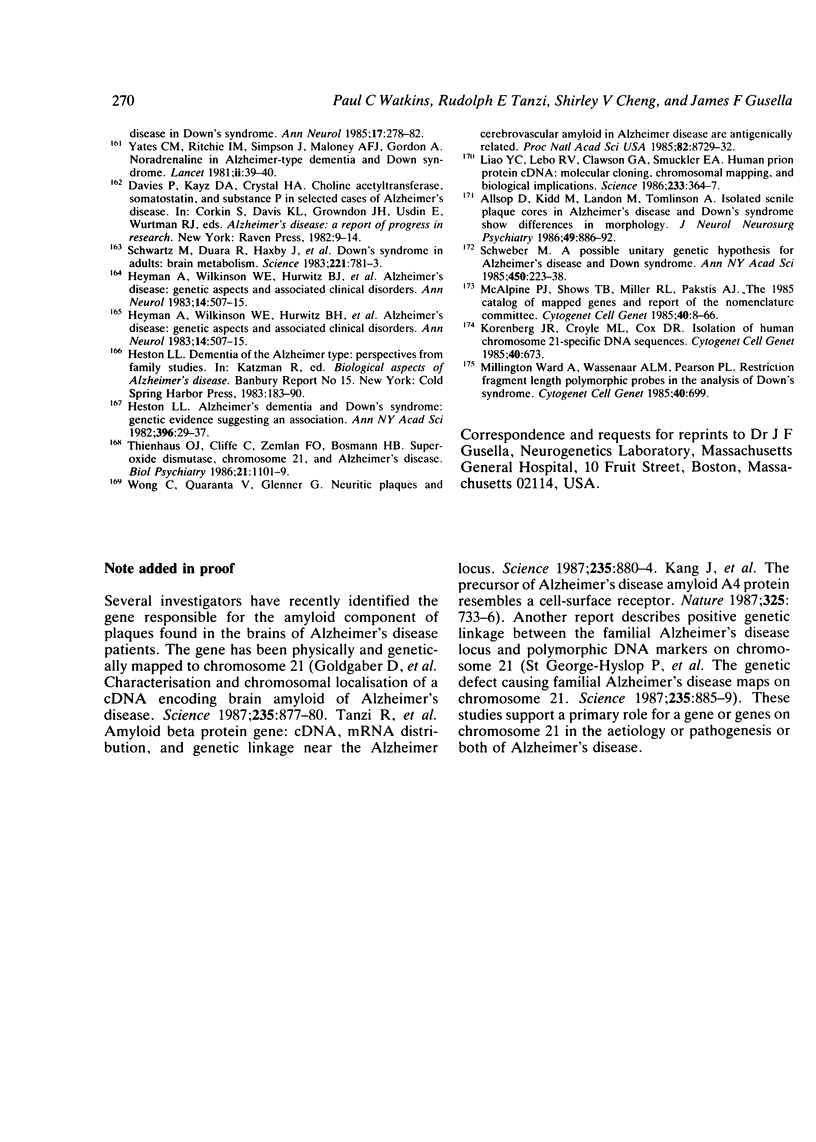
Selected References
These references are in PubMed. This may not be the complete list of references from this article.
- Al-Awadi S. A., Naguib K. K., Teebi A. S., Sundareshan T. S. De novo partial monosomy 21 with unusual karyotype. Jinrui Idengaku Zasshi. 1986 Mar;31(1):45–48. doi: 10.1007/BF01876801. [DOI] [PubMed] [Google Scholar]
- Alfi O. S., Chang R., Azen S. P. Evidence for genetic control of nondisjunction in man. Am J Hum Genet. 1980 Jul;32(4):477–483. [PMC free article] [PubMed] [Google Scholar]
- Allsop D., Kidd M., Landon M., Tomlinson A. Isolated senile plaque cores in Alzheimer's disease and Down's syndrome show differences in morphology. J Neurol Neurosurg Psychiatry. 1986 Aug;49(8):886–892. doi: 10.1136/jnnp.49.8.886. [DOI] [PMC free article] [PubMed] [Google Scholar]
- Anderson D. C., Schmalsteig F. C., Finegold M. J., Hughes B. J., Rothlein R., Miller L. J., Kohl S., Tosi M. F., Jacobs R. L., Waldrop T. C. The severe and moderate phenotypes of heritable Mac-1, LFA-1 deficiency: their quantitative definition and relation to leukocyte dysfunction and clinical features. J Infect Dis. 1985 Oct;152(4):668–689. doi: 10.1093/infdis/152.4.668. [DOI] [PubMed] [Google Scholar]
- Anderson D. C., Schmalstieg F. C., Arnaout M. A., Kohl S., Tosi M. F., Dana N., Buffone G. J., Hughes B. J., Brinkley B. R., Dickey W. D. Abnormalities of polymorphonuclear leukocyte function associated with a heritable deficiency of high molecular weight surface glycoproteins (GP138): common relationship to diminished cell adherence. J Clin Invest. 1984 Aug;74(2):536–551. doi: 10.1172/JCI111451. [DOI] [PMC free article] [PubMed] [Google Scholar]
- Antonarakis S. E., Kittur S. D., Metaxotou C., Watkins P. C., Patel A. S. Analysis of DNA haplotypes suggests a genetic predisposition to trisomy 21 associated with DNA sequences on chromosome 21. Proc Natl Acad Sci U S A. 1985 May;82(10):3360–3364. doi: 10.1073/pnas.82.10.3360. [DOI] [PMC free article] [PubMed] [Google Scholar]
- Arnheim N., Krystal M., Schmickel R., Wilson G., Ryder O., Zimmer E. Molecular evidence for genetic exchanges among ribosomal genes on nonhomologous chromosomes in man and apes. Proc Natl Acad Sci U S A. 1980 Dec;77(12):7323–7327. doi: 10.1073/pnas.77.12.7323. [DOI] [PMC free article] [PubMed] [Google Scholar]
- Aula P., Leisti J., von Koskull H. Partial trisomy 21. Clin Genet. 1973;4(3):241–251. doi: 10.1111/j.1399-0004.1973.tb01149.x. [DOI] [PubMed] [Google Scholar]
- Ball M. J., Nuttall K. Neurofibrillary tangles, granulovacuolar degeneration, and neuron loss in Down Syndrome: quantitative comparison with Alzheimer dementia. Ann Neurol. 1980 May;7(5):462–465. doi: 10.1002/ana.410070512. [DOI] [PubMed] [Google Scholar]
- Bartley J. A., Epstein C. J. Gene dosage effect for glycinamide ribonucleotide synthetase in human fibroblasts trisomic for chromosome 21. Biochem Biophys Res Commun. 1980 Apr 29;93(4):1286–1289. doi: 10.1016/0006-291x(80)90629-4. [DOI] [PubMed] [Google Scholar]
- Beatty P. G., Ledbetter J. A., Martin P. J., Price T. H., Hansen J. A. Definition of a common leukocyte cell-surface antigen (Lp95-150) associated with diverse cell-mediated immune functions. J Immunol. 1983 Dec;131(6):2913–2918. [PubMed] [Google Scholar]
- Bodemann H. H., Tanzi-Fetta R. F., Schröter-Urban H., Volk B. A., Keul J., Löhr G. W. Ferritin in erythrocytes and plasma of patients with iron overload. Blut. 1985 Jul;51(1):25–31. doi: 10.1007/BF00320597. [DOI] [PubMed] [Google Scholar]
- Brun A., Gustafson L. Distribution of cerebral degeneration in Alzheimer's disease. A clinico-pathological study. Arch Psychiatr Nervenkr (1970) 1976 Dec 31;223(1):15–33. doi: 10.1007/BF00367450. [DOI] [PubMed] [Google Scholar]
- Chadefaux B., Allard D., Rethoré M. O., Raoul O., Poissonnier M., Gilgenkrantz S., Cheruy C., Jérôme H. Assignment of human phosphoribosylglycinamide synthetase locus to region 21q221. Hum Genet. 1984;66(2-3):190–192. doi: 10.1007/BF00286599. [DOI] [PubMed] [Google Scholar]
- Chadefaux B., Rethoré M. O., Allard D. Regional mapping of liver type 6 phosphofructokinase isoenzyme on chromosome 21. Hum Genet. 1984;68(2):136–137. doi: 10.1007/BF00279302. [DOI] [PubMed] [Google Scholar]
- Chany C., Vignal M., Couillin P., Van Cong N., Boué J., Boué A. Chromosomal localization of human genes governing the interferon-induced antiviral state. Proc Natl Acad Sci U S A. 1975 Aug;72(8):3129–3133. doi: 10.1073/pnas.72.8.3129. [DOI] [PMC free article] [PubMed] [Google Scholar]
- Crosti N., Serra A., Rigo A., Viglino P. Dosage effect of SOD-A gene in 21-trisomic cells. Hum Genet. 1976 Feb 29;31(2):197–202. doi: 10.1007/BF00296146. [DOI] [PubMed] [Google Scholar]
- Cutler N. R., Heston L. L., Davies P., Haxby J. V., Schapiro M. B. NIH Conference. Alzheimer's disease and Down's syndrome: new insights. Ann Intern Med. 1985 Oct;103(4):566–578. doi: 10.7326/0003-4819-103-4-566. [DOI] [PubMed] [Google Scholar]
- Davidson M., Collins M., Byrne J., Vora S. Alterations in phosphofructokinase isoenzymes during early human development. Establishment of adult organ-specific patterns. Biochem J. 1983 Sep 15;214(3):703–710. doi: 10.1042/bj2140703. [DOI] [PMC free article] [PubMed] [Google Scholar]
- Devilee P., Slagboom P., Cornelisse C. J., Pearson P. L. Sequence heterogeneity within the human alphoid repetitive DNA family. Nucleic Acids Res. 1986 Mar 11;14(5):2059–2073. doi: 10.1093/nar/14.5.2059. [DOI] [PMC free article] [PubMed] [Google Scholar]
- Epstein C. J., Cox D. R., Epstein L. B. Mouse trisomy 16: an animal model of human trisomy 21 (Down syndrome). Ann N Y Acad Sci. 1985;450:157–168. doi: 10.1111/j.1749-6632.1985.tb21490.x. [DOI] [PubMed] [Google Scholar]
- Erickson J. M., Schmickel R. D. A molecular basis for discrete size variation in human ribosomal DNA. Am J Hum Genet. 1985 Mar;37(2):311–325. [PMC free article] [PubMed] [Google Scholar]
- Feaster W. W., Kwok L. W., Epstein C. J. Dosage effects for superoxide dismutase-1 in nucleated cells aneuploid for chromosome 21. Am J Hum Genet. 1977 Nov;29(6):563–570. [PMC free article] [PubMed] [Google Scholar]
- Fishman M. A. Will the study of Down syndrome solve the riddle of Alzheimer disease? J Pediatr. 1986 Apr;108(4):627–629. doi: 10.1016/s0022-3476(86)80854-x. [DOI] [PubMed] [Google Scholar]
- Fitzgerald P. H., Archer S. A., Morris C. M. Evidence for the repeated primary non-disjunction of chromosome 21 as a result of premature centromere division (PCD). Hum Genet. 1986 Jan;72(1):58–62. doi: 10.1007/BF00278818. [DOI] [PubMed] [Google Scholar]
- Fournier A., Zhang Z. Q., Tan Y. H. Human beta:alpha but not gamma interferon binding site is a product of the chromosome 21 interferon action gene. Somat Cell Mol Genet. 1985 May;11(3):291–295. doi: 10.1007/BF01534686. [DOI] [PubMed] [Google Scholar]
- Gardiner K., Laas W., Patterson D. Fractionation of large mammalian DNA restriction fragments using vertical pulsed-field gradient gel electrophoresis. Somat Cell Mol Genet. 1986 Mar;12(2):185–195. doi: 10.1007/BF01560665. [DOI] [PubMed] [Google Scholar]
- Goodpasture C., Bloom S. E., Hsu T. C., Arrighi F. E. Human nucleolus organizers: the satellites or the stalks? Am J Hum Genet. 1976 Nov;28(6):559–566. [PMC free article] [PubMed] [Google Scholar]
- Goodpasture C., Bloom S. E. Visualization of nucleolar organizer regions im mammalian chromosomes using silver staining. Chromosoma. 1975 Nov 20;53(1):37–50. doi: 10.1007/BF00329389. [DOI] [PubMed] [Google Scholar]
- Gosden J. R., Lawrie S. S., Gosden C. M. Satellite DNA sequences in the human acrocentric chromosomes: information from translocations and heteromorphisms. Am J Hum Genet. 1981 Mar;33(2):243–251. [PMC free article] [PubMed] [Google Scholar]
- Gripenberg U., Elfving J., Gripenberg L. A 45,XX,21--child: attempt at a cytological and clinical interpretation of the karyotype. J Med Genet. 1972 Mar;9(1):110–115. doi: 10.1136/jmg.9.1.110. [DOI] [PMC free article] [PubMed] [Google Scholar]
- Hagemeijer A., Smit E. M. Partial trisomy 21. Further evidence that trisomy of band 21q22 is essential for Down's phenotype. Hum Genet. 1977 Aug 31;38(1):15–23. doi: 10.1007/BF00295803. [DOI] [PubMed] [Google Scholar]
- Halloran K. H., Breg W. R., Mahoney M. J. 21 monosomy in a retarded female infant. J Med Genet. 1974 Dec;11(4):386–389. doi: 10.1136/jmg.11.4.386. [DOI] [PMC free article] [PubMed] [Google Scholar]
- Hansson A., Mikkelsen M. The origin of the extra chromosome 21 in Down syndrome. Studies of fluorescent variants and satelite association in 26 informative families. Cytogenet Cell Genet. 1978;20(1-6):194–203. doi: 10.1159/000130851. [DOI] [PubMed] [Google Scholar]
- Hards R. G., Benkovic S. J., Van Keuren M. L., Graw S. L., Drabkin H. A., Patterson D. Assignment of a third purine biosynthetic gene (glycinamide ribonucleotide transformylase) to human chromosome 21. Am J Hum Genet. 1986 Aug;39(2):179–185. [PMC free article] [PubMed] [Google Scholar]
- Hassold T., Chiu D., Yamane J. A. Parental origin of autosomal trisomies. Ann Hum Genet. 1984 May;48(Pt 2):129–144. doi: 10.1111/j.1469-1809.1984.tb01008.x. [DOI] [PubMed] [Google Scholar]
- Hecht F., Hecht B. K., Morgan R., Sandberg A. A., Link M. P. Chromosome clues to acute leukemia in Down's syndrome. Cancer Genet Cytogenet. 1986 Mar 15;21(2):93–98. doi: 10.1016/0165-4608(86)90034-8. [DOI] [PubMed] [Google Scholar]
- Henderson A. S., Warburton D., Atwood K. C. Location of ribosomal DNA in the human chromosome complement. Proc Natl Acad Sci U S A. 1972 Nov;69(11):3394–3398. doi: 10.1073/pnas.69.11.3394. [DOI] [PMC free article] [PubMed] [Google Scholar]
- Heston L. L. Alzheimer's dementia and Down's syndrome: genetic evidence suggesting an association. Ann N Y Acad Sci. 1982;396:29–37. doi: 10.1111/j.1749-6632.1982.tb26841.x. [DOI] [PubMed] [Google Scholar]
- Heston L. L. Down's syndrome and Alzheimer's dementia: defining an association. Psychiatr Dev. 1984 Winter;2(4):287–294. [PubMed] [Google Scholar]
- Heyman A., Wilkinson W. E., Hurwitz B. J., Schmechel D., Sigmon A. H., Weinberg T., Helms M. J., Swift M. Alzheimer's disease: genetic aspects and associated clinical disorders. Ann Neurol. 1983 Nov;14(5):507–515. doi: 10.1002/ana.410140503. [DOI] [PubMed] [Google Scholar]
- Holmes L. B. Genetic counseling for the older pregnant woman: new data and questions. N Engl J Med. 1978 Jun 22;298(25):1419–1421. doi: 10.1056/NEJM197806222982511. [DOI] [PubMed] [Google Scholar]
- Huret J. L., Leonard C., Kanoui V. Ring chromosome 21 in a phenotypically normal but infertile man. Clin Genet. 1985 Dec;28(6):541–545. doi: 10.1111/j.1399-0004.1985.tb00423.x. [DOI] [PubMed] [Google Scholar]
- Jackson-Cook C. K., Flannery D. B., Corey L. A., Nance W. E., Brown J. A. Nucleolar organizer region variants as a risk factor for Down syndrome. Am J Hum Genet. 1985 Nov;37(6):1049–1061. [PMC free article] [PubMed] [Google Scholar]
- Jacobs P. A., Mayer M., Morton N. E. Acrocentric chromosome associations in man. Am J Hum Genet. 1976 Nov;28(6):567–576. [PMC free article] [PubMed] [Google Scholar]
- Juberg R. C., Mowrey P. N. Origin of nondisjunction in trisomy 21 syndrome: all studies compiled, parental age analysis, and international comparisons. Am J Med Genet. 1983 Sep;16(1):111–116. doi: 10.1002/ajmg.1320160117. [DOI] [PubMed] [Google Scholar]
- Kazazian H. H., Jr, Antonarakis S. E., Wong C., Trusko S. P., Stetten G., Oliver M., Potter M. J., Gusella J. F., Watkins P. C. Ring chromosome 21: characterization of DNA sequences at sites of breakage and reunion. Ann N Y Acad Sci. 1985;450:33–42. doi: 10.1111/j.1749-6632.1985.tb21481.x. [DOI] [PubMed] [Google Scholar]
- Kittur S. D., Antonarakis S. E., Tanzi R. E., Meyers D. A., Chakravarti A., Groner Y., Phillips J. A., Watkins P. C., Gusella J. F., Kazazian H. H., Jr A linkage map of three anonymous human DNA fragments and SOD-1 on chromosome 21. EMBO J. 1985 Sep;4(9):2257–2260. doi: 10.1002/j.1460-2075.1985.tb03923.x. [DOI] [PMC free article] [PubMed] [Google Scholar]
- Kohl S., Springer T. A., Schmalstieg F. C., Loo L. S., Anderson D. C. Defective natural killer cytotoxicity and polymorphonuclear leukocyte antibody-dependent cellular cytotoxicity in patients with LFA-1/OKM-1 deficiency. J Immunol. 1984 Dec;133(6):2972–2978. [PubMed] [Google Scholar]
- Krumlauf R., Jeanpierre M., Young B. D. Construction and characterization of genomic libraries from specific human chromosomes. Proc Natl Acad Sci U S A. 1982 May;79(9):2971–2975. doi: 10.1073/pnas.79.9.2971. [DOI] [PMC free article] [PubMed] [Google Scholar]
- Kurnit D. M., Roy S., Stewart G. D., Schwedock J., Neve R. L., Bruns G. A., Van Keuren M. L., Patterson D. The 724 family of DNA sequences is interspersed about the pericentromeric regions of human acrocentric chromosomes. Cytogenet Cell Genet. 1986;43(1-2):109–116. doi: 10.1159/000132305. [DOI] [PubMed] [Google Scholar]
- LEJEUNE J., GAUTHIER M., TURPIN R. Les chromosomes humains en culture de tissus. C R Hebd Seances Acad Sci. 1959 Jan 26;248(4):602–603. [PubMed] [Google Scholar]
- Liao Y. C., Lebo R. V., Clawson G. A., Smuckler E. A. Human prion protein cDNA: molecular cloning, chromosomal mapping, and biological implications. Science. 1986 Jul 18;233(4761):364–367. doi: 10.1126/science.3014653. [DOI] [PubMed] [Google Scholar]
- Lieman-Hurwitz J., Dafni N., Lavie V., Groner Y. Human cytoplasmic superoxide dismutase cDNA clone: a probe for studying the molecular biology of Down syndrome. Proc Natl Acad Sci U S A. 1982 May;79(9):2808–2811. doi: 10.1073/pnas.79.9.2808. [DOI] [PMC free article] [PubMed] [Google Scholar]
- Lott I. T. Down's syndrome, aging, and Alzheimer's disease: a clinical review. Ann N Y Acad Sci. 1982;396:15–27. doi: 10.1111/j.1749-6632.1982.tb26840.x. [DOI] [PubMed] [Google Scholar]
- Mann D. M., Yates P. O., Marcyniuk B. Alzheimer's presenile dementia, senile dementia of Alzheimer type and Down's syndrome in middle age form an age related continuum of pathological changes. Neuropathol Appl Neurobiol. 1984 May-Jun;10(3):185–207. doi: 10.1111/j.1365-2990.1984.tb00351.x. [DOI] [PubMed] [Google Scholar]
- Manuelidis L., Wu J. C. Homology between human and simian repeated DNA. Nature. 1978 Nov 2;276(5683):92–94. doi: 10.1038/276092a0. [DOI] [PubMed] [Google Scholar]
- Marković V. D., Worton R. G., Berg J. M. Evidence for the inheritance of silver-stained nucleolus organizer regions. Hum Genet. 1978 Mar 17;41(2):181–187. doi: 10.1007/BF00273100. [DOI] [PubMed] [Google Scholar]
- Marlin S. D., Morton C. C., Anderson D. C., Springer T. A. LFA-1 immunodeficiency disease. Definition of the genetic defect and chromosomal mapping of alpha and beta subunits of the lymphocyte function-associated antigen 1 (LFA-1) by complementation in hybrid cells. J Exp Med. 1986 Sep 1;164(3):855–867. doi: 10.1084/jem.164.3.855. [DOI] [PMC free article] [PubMed] [Google Scholar]
- Masiakowski P., Breathnach R., Bloch J., Gannon F., Krust A., Chambon P. Cloning of cDNA sequences of hormone-regulated genes from the MCF-7 human breast cancer cell line. Nucleic Acids Res. 1982 Dec 20;10(24):7895–7903. doi: 10.1093/nar/10.24.7895. [DOI] [PMC free article] [PubMed] [Google Scholar]
- Mattei J. F., Ayme S., Mattei M. G., Giraud F. Maternal age and origin of non-disjunction in trisomy 21. J Med Genet. 1980 Oct;17(5):368–372. doi: 10.1136/jmg.17.5.368. [DOI] [PMC free article] [PubMed] [Google Scholar]
- Mattei J. F., Mattei M. G., Baeteman M. A., Giraud F. Trisomy 21 for the region 21q223: identification by high-resolution R-banding patterns. Hum Genet. 1981;56(3):409–411. doi: 10.1007/BF00274703. [DOI] [PubMed] [Google Scholar]
- McAlpine P. J., Shows T. B., Miller R. L., Pakstis A. J. The 1985 Catalog of Mapped Genes and report of the Nomenclature Committee. Cytogenet Cell Genet. 1985;40(1-4):8–66. doi: 10.1159/000132168. [DOI] [PubMed] [Google Scholar]
- Meakin S. O., Breitman M. L., Tsui L. C. Structural and evolutionary relationships among five members of the human gamma-crystallin gene family. Mol Cell Biol. 1985 Jun;5(6):1408–1414. doi: 10.1128/mcb.5.6.1408. [DOI] [PMC free article] [PubMed] [Google Scholar]
- Mikkelsen M. Parental origin of the extra chromosome in Down's Syndrome. J Ment Defic Res. 1982 Sep;26(Pt 3):143–151. doi: 10.1111/j.1365-2788.1982.tb00141.x. [DOI] [PubMed] [Google Scholar]
- Mikkelsen M., Vestermark S. Karyotype 45,XX,-21/46,XX,21q-in an infant with symptoms of G-deletion syndrome I. J Med Genet. 1974 Dec;11(4):389–393. doi: 10.1136/jmg.11.4.389. [DOI] [PMC free article] [PubMed] [Google Scholar]
- Miller D. A., Dev V. G., Tantravahi R., Miller O. J. Suppression of human nucleolus organizer activity in mouse-human somatic hybrid cells. Exp Cell Res. 1976 Sep;101(2):235–243. doi: 10.1016/0014-4827(76)90373-6. [DOI] [PubMed] [Google Scholar]
- Miller D. A., Tantravahi R., Dev V. G., Miller O. J. Frequency of satellite association of human chromosomes is correlated with amount of Ag-staining of the nucleolus organizer region. Am J Hum Genet. 1977 Sep;29(5):490–502. [PMC free article] [PubMed] [Google Scholar]
- Mirre C., Hartung M., Stahl A. Association of ribosomal genes in the fibrillar center of the nucleolus: a factor influencing translocation and nondisjunction in the human meiotic oocyte. Proc Natl Acad Sci U S A. 1980 Oct;77(10):6017–6021. doi: 10.1073/pnas.77.10.6017. [DOI] [PMC free article] [PubMed] [Google Scholar]
- Mogensen K. E., Vignaux F., Gresser I. Enhanced expression of cellular receptors for human interferon alpha on peripheral lymphocytes from patients with Down's syndrome. FEBS Lett. 1982 Apr 19;140(2):285–287. doi: 10.1016/0014-5793(82)80915-0. [DOI] [PubMed] [Google Scholar]
- Moore E. E., Jones C., Kao F. T., Oates D. C. Synteny between glycinamide ribonucleotide synthetase and superoxide dismutase (soluble). Am J Hum Genet. 1977 Jul;29(4):389–396. [PMC free article] [PubMed] [Google Scholar]
- OHNO S., TRUJILLO J. M., KAPLAN W. D., KINOSITA R. Nucleolus-organisers in the causation of chromosomal anomalies in man. Lancet. 1961 Jul 15;2(7194):123–126. doi: 10.1016/s0140-6736(61)92647-2. [DOI] [PubMed] [Google Scholar]
- Patarroyo M., Beatty P. G., Fabre J. W., Gahmberg C. G. Identification of a cell surface protein complex mediating phorbol ester-induced adhesion (binding) among human mononuclear leukocytes. Scand J Immunol. 1985 Aug;22(2):171–182. doi: 10.1111/j.1365-3083.1985.tb01869.x. [DOI] [PubMed] [Google Scholar]
- Patarroyo M., Beatty P. G., Serhan C. N., Gahmberg C. G. Identification of a cell-surface glycoprotein mediating adhesion in human granulocytes. Scand J Immunol. 1985 Dec;22(6):619–631. doi: 10.1111/j.1365-3083.1985.tb01924.x. [DOI] [PubMed] [Google Scholar]
- Patterson D., Graw S., Jones C. Demonstration, by somatic cell genetics, of coordinate regulation of genes for two enzymes of purine synthesis assigned to human chromosome 21. Proc Natl Acad Sci U S A. 1981 Jan;78(1):405–409. doi: 10.1073/pnas.78.1.405. [DOI] [PMC free article] [PubMed] [Google Scholar]
- Poissonnier M., Saint-Paul B., Dutrillaux B., Chassaigne M., Gruyer P., de Blignières-Strouk G. Trisomie 21 partielle (21q21 leads to 21q22.2) Ann Genet. 1976 Mar;19(1):69–73. [PubMed] [Google Scholar]
- Poissonnier M., Saint-Paul B., Dutrillaux B., Chassaigne M., Gruyer P., de Blignières-Strouk G. Trisomie 21 partielle (21q21 leads to 21q22.2) Ann Genet. 1976 Mar;19(1):69–73. [PubMed] [Google Scholar]
- Price D. L., Whitehouse P. J., Struble R. G., Coyle J. T., Clark A. W., Delong M. R., Cork L. C., Hedreen J. C. Alzheimer's disease and Down's syndrome. Ann N Y Acad Sci. 1982;396:145–164. doi: 10.1111/j.1749-6632.1982.tb26850.x. [DOI] [PubMed] [Google Scholar]
- Prud'homme J. F., Fridlansky F., Le Cunff M., Atger M., Mercier-Bodart C., Pichon M. F., Milgrom E. Cloning of a gene expressed in human breast cancer and regulated by estrogen in MCF-7 cells. DNA. 1985 Feb;4(1):11–21. doi: 10.1089/dna.1985.4.11. [DOI] [PubMed] [Google Scholar]
- Raziuddin A., Sarkar F. H., Dutkowski R., Shulman L., Ruddle F. H., Gupta S. L. Receptors for human alpha and beta interferon but not for gamma interferon are specified by human chromosome 21. Proc Natl Acad Sci U S A. 1984 Sep;81(17):5504–5508. doi: 10.1073/pnas.81.17.5504. [DOI] [PMC free article] [PubMed] [Google Scholar]
- Reeves R. H., Gearhart J. D., Littlefield J. W. Genetic basis for a mouse model of Down syndrome. Brain Res Bull. 1986 Jun;16(6):803–814. doi: 10.1016/0361-9230(86)90076-6. [DOI] [PubMed] [Google Scholar]
- Rethoré M. O., Dutrillaux B., Baheux G., Gerveaux J., Lejeune J. Monosomie pour les régions juxtacentroméruqyes d'un chromosome 21. Exp Cell Res. 1972 Feb;70(2):455–456. doi: 10.1016/0014-4827(72)90164-4. [DOI] [PubMed] [Google Scholar]
- Rethoré M. O., Dutrillaux B. Translocation 46,XX, t(15; 21) (q13; q22,1) chez la mère de deux enfants atteints de trisomie 15 et de monosomie 21 partielles. Ann Genet. 1973 Dec;16(4):271–275. [PubMed] [Google Scholar]
- Rivera H., Rivas F., Plascencia L., Cantú J. M. "Pure" monosomy 21 pter leads to q21 in a girl born to a couple 46,XX,t(14;21)(p12;q22) and 46,XY,t(5;18)(q32;q22). Ann Genet. 1983;26(4):234–237. [PubMed] [Google Scholar]
- Ropper A. H., Williams R. S. Relationship between plaques, tangles, and dementia in Down syndrome. Neurology. 1980 Jun;30(6):639–644. doi: 10.1212/wnl.30.6.639. [DOI] [PubMed] [Google Scholar]
- Sanchez-Madrid F., Nagy J. A., Robbins E., Simon P., Springer T. A. A human leukocyte differentiation antigen family with distinct alpha-subunits and a common beta-subunit: the lymphocyte function-associated antigen (LFA-1), the C3bi complement receptor (OKM1/Mac-1), and the p150,95 molecule. J Exp Med. 1983 Dec 1;158(6):1785–1803. doi: 10.1084/jem.158.6.1785. [DOI] [PMC free article] [PubMed] [Google Scholar]
- Schmickel R. D., Gonzalez I. L., Erickson J. M. Nucleolus organizing genes on chromosome 21: recombination and nondisjunction. Ann N Y Acad Sci. 1985;450:121–131. doi: 10.1111/j.1749-6632.1985.tb21488.x. [DOI] [PubMed] [Google Scholar]
- Schmickel R. D. Quantitation of human ribosomal DNA: hybridization of human DNA with ribosomal RNA for quantitation and fractionation. Pediatr Res. 1973 Jan;7(1):5–12. doi: 10.1203/00006450-197301000-00002. [DOI] [PubMed] [Google Scholar]
- Schmid W., Tenconi R., Baccichetti C., Caufin D., Schinzel A. Ring chromosome 21 in phenotypically apparently normal persons: report of two families from Switzerland and Italy. Am J Med Genet. 1983 Nov;16(3):323–329. doi: 10.1002/ajmg.1320160305. [DOI] [PubMed] [Google Scholar]
- Schwartz M., Duara R., Haxby J., Grady C., White B. J., Kessler R. M., Kay A. D., Cutler N. R., Rapoport S. I. Down's syndrome in adults: brain metabolism. Science. 1983 Aug 19;221(4612):781–783. doi: 10.1126/science.6224294. [DOI] [PubMed] [Google Scholar]
- Schweber M. A possible unitary genetic hypothesis for Alzheimer's disease and Down syndrome. Ann N Y Acad Sci. 1985;450:223–238. doi: 10.1111/j.1749-6632.1985.tb21495.x. [DOI] [PubMed] [Google Scholar]
- Sherman L., Dafni N., Lieman-Hurwitz J., Groner Y. Nucleotide sequence and expression of human chromosome 21-encoded superoxide dismutase mRNA. Proc Natl Acad Sci U S A. 1983 Sep;80(18):5465–5469. doi: 10.1073/pnas.80.18.5465. [DOI] [PMC free article] [PubMed] [Google Scholar]
- Sherman L., Levanon D., Lieman-Hurwitz J., Dafni N., Groner Y. Human Cu/Zn superoxide dismutase gene: molecular characterization of its two mRNA species. Nucleic Acids Res. 1984 Dec 21;12(24):9349–9365. doi: 10.1093/nar/12.24.9349. [DOI] [PMC free article] [PubMed] [Google Scholar]
- Sinet P. M., Allard D., Lejeune J., Jérôme H. Augmentation d'activité de la superoxyde dismutase érythrocytaire dans la trisomie pour le chromosome 21. C R Acad Sci Hebd Seances Acad Sci D. 1974 Jun 17;278(25):3267–3270. [PubMed] [Google Scholar]
- Sinet P. M., Couturier J., Dutrillaux B., Poissonnier M., Raoul O., Rethore M. O., Allard D., Lejeune J., Jerome H. Trisomie 21 et superoxyde dismutase-1 (IPO-A). Tentative de localisation sur la sous bande 21Q22.1. Exp Cell Res. 1976 Jan;97:47–55. doi: 10.1016/0014-4827(76)90653-4. [DOI] [PubMed] [Google Scholar]
- Sinet P. M., Couturier J., Dutrillaux B., Poissonnier M., Raoul O., Rethore M. O., Allard D., Lejeune J., Jerome H. Trisomie 21 et superoxyde dismutase-1 (IPO-A). Tentative de localisation sur la sous bande 21Q22.1. Exp Cell Res. 1976 Jan;97:47–55. doi: 10.1016/0014-4827(76)90653-4. [DOI] [PubMed] [Google Scholar]
- Skovby F., Krassikoff N., Francke U. Assignment of the gene for cystathionine beta-synthase to human chromosome 21 in somatic cell hybrids. Hum Genet. 1984;65(3):291–294. doi: 10.1007/BF00286520. [DOI] [PubMed] [Google Scholar]
- Smith G. F., Warren S. T. The biology of Down syndrome. Ann N Y Acad Sci. 1985;450:1–9. doi: 10.1111/j.1749-6632.1985.tb21478.x. [DOI] [PubMed] [Google Scholar]
- Springer T. A., Thompson W. S., Miller L. J., Schmalstieg F. C., Anderson D. C. Inherited deficiency of the Mac-1, LFA-1, p150,95 glycoprotein family and its molecular basis. J Exp Med. 1984 Dec 1;160(6):1901–1918. doi: 10.1084/jem.160.6.1901. [DOI] [PMC free article] [PubMed] [Google Scholar]
- St George-Hyslop P. H., Tanzi R. E., Polinsky R. J., Haines J. L., Nee L., Watkins P. C., Myers R. H., Feldman R. G., Pollen D., Drachman D. The genetic defect causing familial Alzheimer's disease maps on chromosome 21. Science. 1987 Feb 20;235(4791):885–890. doi: 10.1126/science.2880399. [DOI] [PubMed] [Google Scholar]
- Stewart G. D., Harris P., Galt J., Ferguson-Smith M. A. Cloned DNA probes regionally mapped to human chromosome 21 and their use in determining the origin of nondisjunction. Nucleic Acids Res. 1985 Jun 11;13(11):4125–4132. doi: 10.1093/nar/13.11.4125. [DOI] [PMC free article] [PubMed] [Google Scholar]
- Summitt R. L., Martens P. R., Wilroy R. S., Jr X-autosome translocation in normal mother and effectively 21-monosomic daughter. J Pediatr. 1974 Apr;84(4):539–546. doi: 10.1016/s0022-3476(74)80674-8. [DOI] [PubMed] [Google Scholar]
- Suomalainen H. A., Gahmberg C. G., Patarroyo M., Beatty P. G., Schröder J. Genetic assignment of GP90, leukocyte adhesion glycoprotein to human chromosome 21. Somat Cell Mol Genet. 1986 May;12(3):297–302. doi: 10.1007/BF01570789. [DOI] [PubMed] [Google Scholar]
- Tan Y. H., Tischfield J., Ruddle F. H. The linkage of genes for the human interferon-induced antiviral protein and indophenol oxidase-B traits to chromosome G-21. J Exp Med. 1973 Feb 1;137(2):317–330. doi: 10.1084/jem.137.2.317. [DOI] [PMC free article] [PubMed] [Google Scholar]
- Taylor G. M., Williams A., D'Souza S. W. Increased expression of lymphocyte functional antigen in Down syndrome. Lancet. 1986 Sep 27;2(8509):740–740. doi: 10.1016/s0140-6736(86)90248-5. [DOI] [PubMed] [Google Scholar]
- Ternaux J. P., Mattei J. F., Faudon M., Barrit M. C., Ardissone J. P., Giraud F. Peripheral and central 5-hydroxytryptamine in trisomy 21. Life Sci. 1979 Dec 3;25(23):2017–2022. doi: 10.1016/0024-3205(79)90606-4. [DOI] [PubMed] [Google Scholar]
- Tippett P., Kaplan J. C. Report of the Committee on the Genetic Constitution of Chromosomes 20, 21, and 22. Cytogenet Cell Genet. 1985;40(1-4):268–295. doi: 10.1159/000132177. [DOI] [PubMed] [Google Scholar]
- Tomlinson B. E., Blessed G., Roth M. Observations on the brains of demented old people. J Neurol Sci. 1970 Sep;11(3):205–242. doi: 10.1016/0022-510x(70)90063-8. [DOI] [PubMed] [Google Scholar]
- Traub A., Feinstein S., Gez M., Lazar A., Mizrahi A. Purification and properties of the alpha-interferon receptor of human lymphoblastoid (Namalva) cells. J Biol Chem. 1984 Nov 25;259(22):13872–13877. [PubMed] [Google Scholar]
- Van Keuren M. L., Watkins P. C., Drabkin H. A., Jabs E. W., Gusella J. F., Patterson D. Regional localization of DNA sequences on chromosome 21 using somatic cell hybrids. Am J Hum Genet. 1986 Jun;38(6):793–804. [PMC free article] [PubMed] [Google Scholar]
- Van Keuren M., Drabkin H., Hart I., Harker D., Patterson D., Vora S. Regional assignment of human liver-type 6-phosphofructokinase to chromosome 21q22.3 by using somatic cell hybrids and a monoclonal anti-L antibody. Hum Genet. 1986 Sep;74(1):34–40. doi: 10.1007/BF00278782. [DOI] [PubMed] [Google Scholar]
- Verma R. S., Babu A., Chemitiganti S., Dosik H. A possible cause of non-disjunction of additional chromosome 21 in Down syndrome. Mol Gen Genet. 1986 Mar;202(3):339–341. doi: 10.1007/BF00333259. [DOI] [PubMed] [Google Scholar]
- Vora S., Durham S., de Martinville B., George D. L., Francke U. Assignment of the human gene for muscle-type phosphofructokinase (PFKM) to chromosome 1 (region cen leads to q32) using somatic cell hybrids and monoclonal anti-M antibody. Somatic Cell Genet. 1982 Jan;8(1):95–104. doi: 10.1007/BF01538653. [DOI] [PubMed] [Google Scholar]
- Vora S., Francke U. Assignment of the human gene for liver-type 6-phosphofructokinase isozyme (PFKL) to chromosome 21 by using somatic cell hybrids and monoclonal anti-L antibody. Proc Natl Acad Sci U S A. 1981 Jun;78(6):3738–3742. doi: 10.1073/pnas.78.6.3738. [DOI] [PMC free article] [PubMed] [Google Scholar]
- Watkins P. C., Tanzi R. E., Gibbons K. T., Tricoli J. V., Landes G., Eddy R., Shows T. B., Gusella J. F. Isolation of polymorphic DNA segments from human chromosome 21. Nucleic Acids Res. 1985 Sep 11;13(17):6075–6088. doi: 10.1093/nar/13.17.6075. [DOI] [PMC free article] [PubMed] [Google Scholar]
- Watson D. K., McWilliams-Smith M. J., Kozak C., Reeves R., Gearhart J., Nunn M. F., Nash W., Fowle J. R., 3rd, Duesberg P., Papas T. S. Conserved chromosomal positions of dual domains of the ets protooncogene in cats, mice, and humans. Proc Natl Acad Sci U S A. 1986 Mar;83(6):1792–1796. doi: 10.1073/pnas.83.6.1792. [DOI] [PMC free article] [PubMed] [Google Scholar]
- Watson D. K., McWilliams-Smith M. J., Nunn M. F., Duesberg P. H., O'Brien S. J., Papas T. S. The ets sequence from the transforming gene of avian erythroblastosis virus, E26, has unique domains on human chromosomes 11 and 21: both loci are transcriptionally active. Proc Natl Acad Sci U S A. 1985 Nov;82(21):7294–7298. doi: 10.1073/pnas.82.21.7294. [DOI] [PMC free article] [PubMed] [Google Scholar]
- Weber F. M., Sparkes R. S., Muller H. Double monosomy mosaicism (45,X-45, XX,21-) in a retarded child with multiple congenital malformations. Cytogenetics. 1971;10(6):404–412. doi: 10.1159/000130161. [DOI] [PubMed] [Google Scholar]
- Weil D., Cottreau D., Nguyen Van Cong, Rebourcet R., Foubert C., Gross M. S., Dreyfus J. C., Kahn A. Assignment of the gene for F-type phosphofructokinase to human chromosome 10 by somatic cell hybridization and specific immunoprecipitation. Ann Hum Genet. 1980 Jul;44(Pt 1):11–16. doi: 10.1111/j.1469-1809.1980.tb00941.x. [DOI] [PubMed] [Google Scholar]
- Willard H. F., Waye J. S., Skolnick M. H., Schwartz C. E., Powers V. E., England S. B. Detection of restriction fragment length polymorphisms at the centromeres of human chromosomes by using chromosome-specific alpha satellite DNA probes: implications for development of centromere-based genetic linkage maps. Proc Natl Acad Sci U S A. 1986 Aug;83(15):5611–5615. doi: 10.1073/pnas.83.15.5611. [DOI] [PMC free article] [PubMed] [Google Scholar]
- Williams J. D., Summitt R. L., Martens P. R., Kimbrell R. A. Familial Down syndrome due to t(10;21) translocation: evidence that the Down phenotype is related to trisomy of a specific segment of chromosome 21. Am J Hum Genet. 1975 Jul;27(4):478–485. [PMC free article] [PubMed] [Google Scholar]
- Wisniewski K. E., Dalton A. J., McLachlan C., Wen G. Y., Wisniewski H. M. Alzheimer's disease in Down's syndrome: clinicopathologic studies. Neurology. 1985 Jul;35(7):957–961. doi: 10.1212/wnl.35.7.957. [DOI] [PubMed] [Google Scholar]
- Wong L. T., Davidson A. G., Applegarth D. A., Dimmick J. E., Norman M. G., Toone J. R., Pirie G., Wong J. Biochemical and histologic pathology in an infant with cross-reacting material (negative) pyruvate carboxylase deficiency. Pediatr Res. 1986 Mar;20(3):274–279. doi: 10.1203/00006450-198603000-00016. [DOI] [PubMed] [Google Scholar]
- Yates C. M., Ritchie I. M., Simpson J., Maloney A. F., Gordon A. Noradrenaline in Alzheimer-type dementia and Down syndrome. Lancet. 1981 Jul 4;2(8236):39–40. doi: 10.1016/s0140-6736(81)90269-5. [DOI] [PubMed] [Google Scholar]
- Yates C. M., Simpson J., Maloney A. F., Gordon A., Reid A. H. Alzheimer-like cholinergic deficiency in Down syndrome. Lancet. 1980 Nov 1;2(8201):979–979. doi: 10.1016/s0140-6736(80)92137-6. [DOI] [PubMed] [Google Scholar]
- Yeragani V. K., Gershon S. Hammond and lithium: historical update. Biol Psychiatry. 1986 Sep;21(11):1101–1102. doi: 10.1016/0006-3223(86)90296-9. [DOI] [PubMed] [Google Scholar]
- Zhang Z. Q., Fournier A., Tan Y. H. The isolation of human beta-interferon receptor by wheat germ lectin affinity and immunosorbent column chromatographies. J Biol Chem. 1986 Jun 15;261(17):8017–8021. [PubMed] [Google Scholar]
- Zhang Z. X., De Clercq E., Heremans H., Verhaegen-Lewalle M., Content J. Antiviral and anticellular activities of human and murine type I and type II interferons in human cells monosomic, disomic, and trisomic for chromosome 21. Proc Soc Exp Biol Med. 1982 May;170(1):103–111. doi: 10.3181/00379727-170-41405. [DOI] [PubMed] [Google Scholar]


